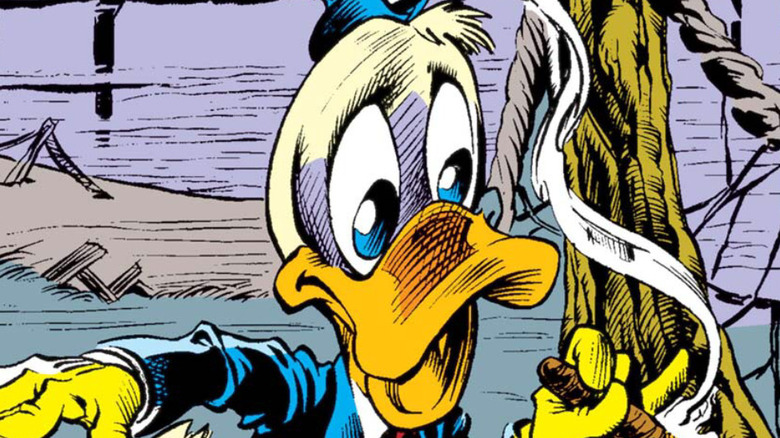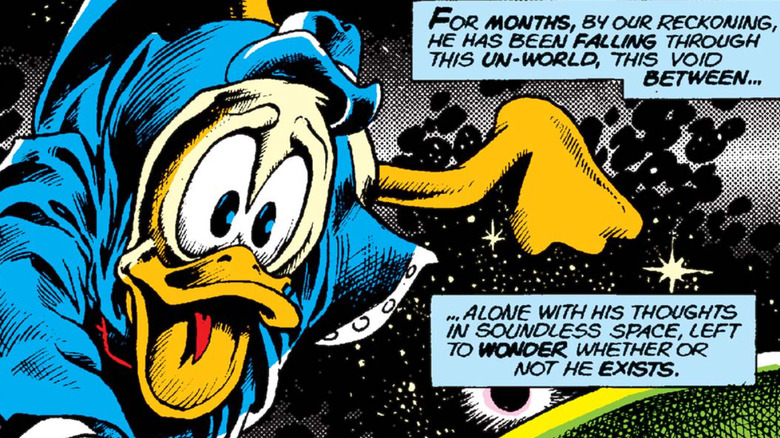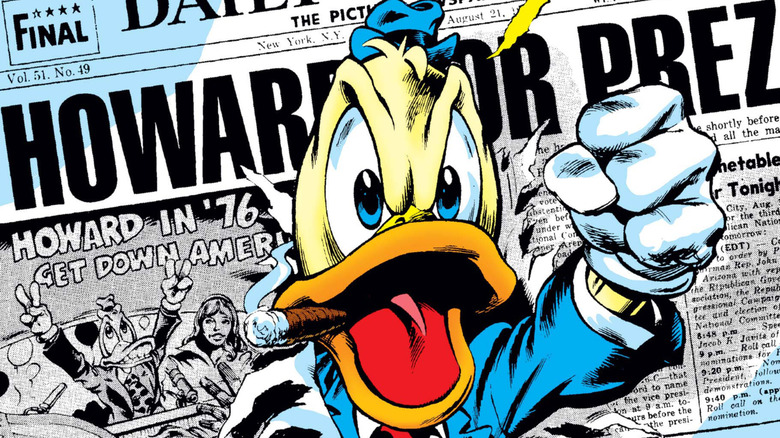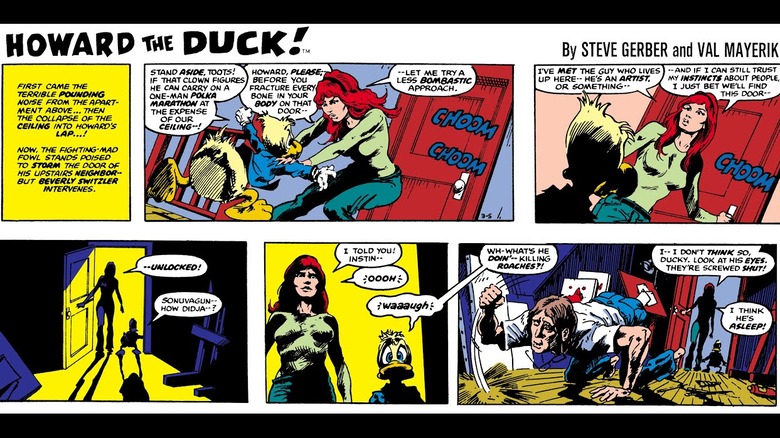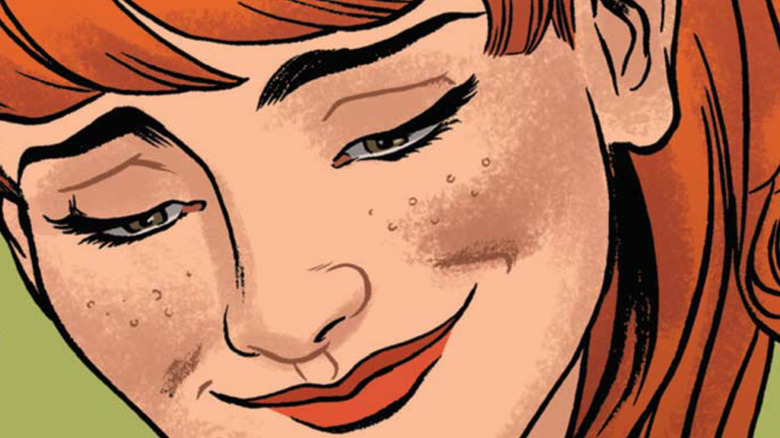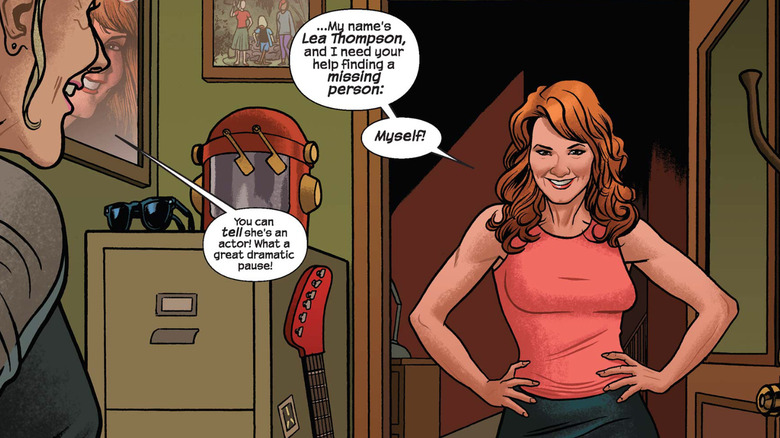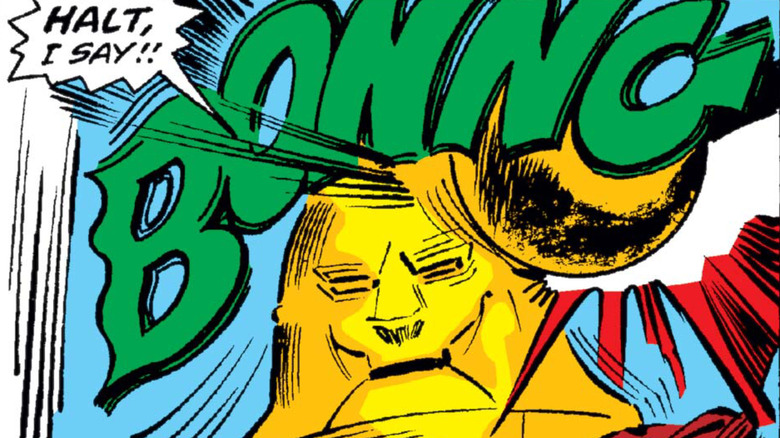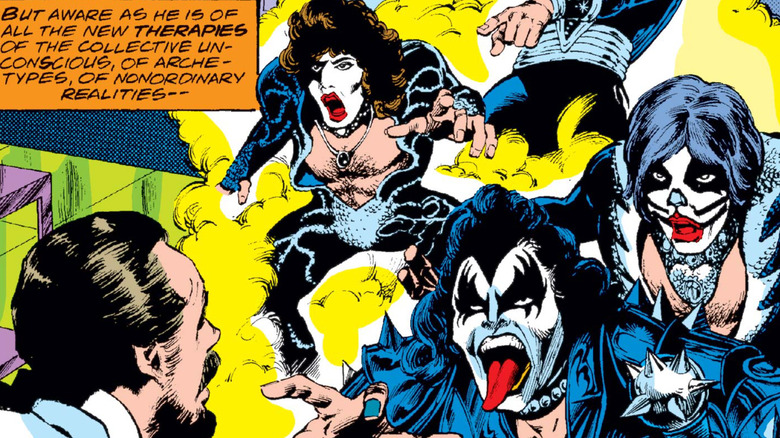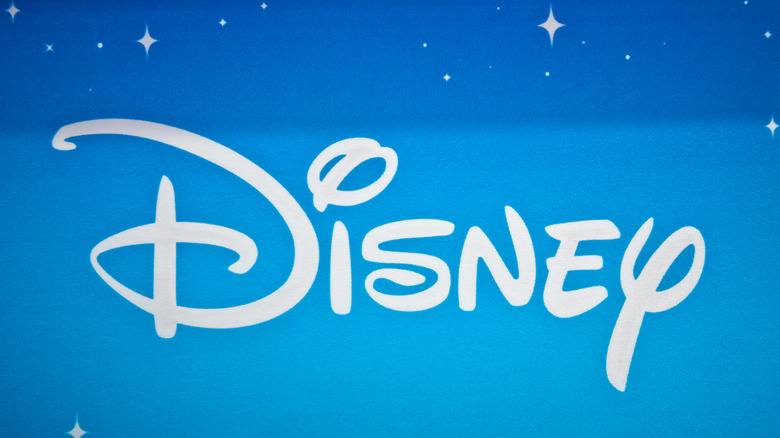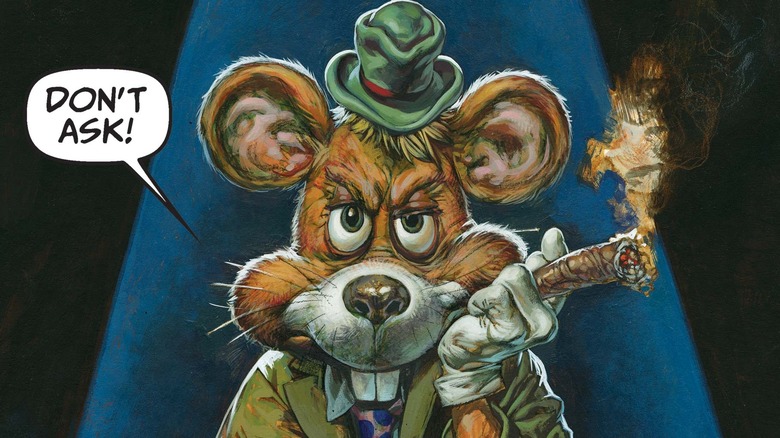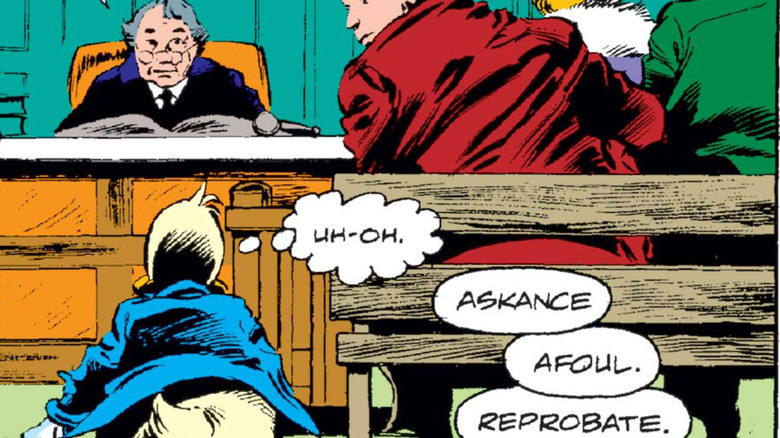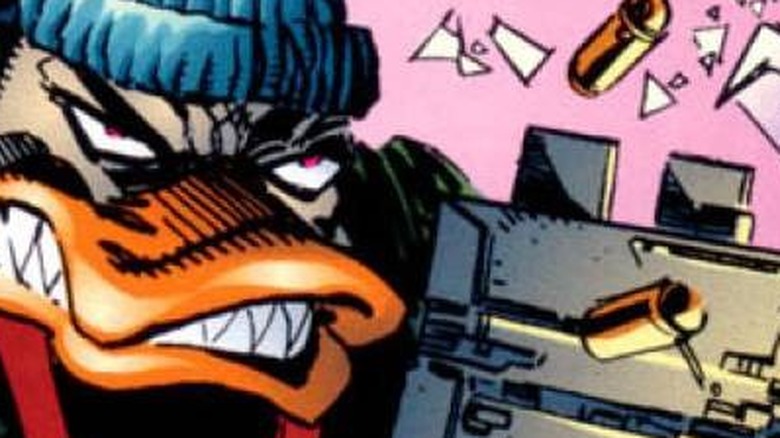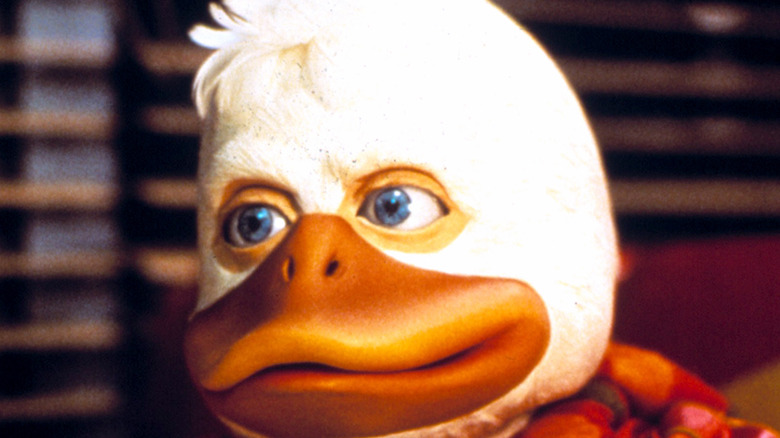The Untold Truth Of Howard The Duck
Back in the 1970s, Marvel's most famous heroes found their popularity rivaled by an unlikely source: a talking duck. Created by writer Steve Gerber and artist Val Mayerik, Howard the Duck first waddled onto the scene in 1973's "Adventures into Fear" #19, quickly winning fans over with his sly observational humor. Howard soon got his own series, fittingly titled "Howard the Duck," which quickly gained legendary status for its one-of-a-kind mixture of hilarity and social commentary. Though this original title ended decades ago, Howard has continued to appear in Marvel Comics ever since, as well as in film and on TV
Yet Howard remains somewhat obscure as far as Marvel characters go. More casual fans may not be aware of the behind-the-scenes legal wars surrounding the character, or that his much-maligned movie (which has since gained a devoted following) changed visual effects forever. They might not know about the famous band that cameoed in Howard's comics, or that Disney has had a longer association with him than any other Marvel character. There's enough Howard trivia out there to make a duck go "Waaaugh!" Out of fascination, that is, rather than Howard's usual frustration.
He began as a one-off character
The great irony of Howard the Duck becoming one of Steve Gerber's signature characters is that the cantankerous duck originally wasn't meant to last. At then-editor Roy Thomas' bidding, Gerber did away with Howard shortly after the character's debut, seemingly dooming him to fall endlessly down a bottomless void between universes in "Man-Thing" #1.
While Gerber and Mayerik may have thought they were done with the duck, fans readily disagreed, begging by mail that Marvel bring Howard back. Leading the charge, according to "Howard the Duck Magazine" #9, was the fanzine "Contemporary Pictorial Literature," better known as "CBL," whose contributors included future comic stars like Roger Stern, Bill Mantlo, and Steven Grant, the last two of whom would later write Howard the Duck comics themselves.
They're probably not the fans behind the most outrageous attempt to bring back Howard, namely a letter accusing Marvel of murder that was accompanied by the remains of a duck Christmas dinner. Suffice to say, Marvel listened, and Howard reappeared in "Giant-Size Man-Thing" #4, ending his long drop by making a surprisingly gentle landing in Cleveland, Ohio.
Howard's famous run for president began in the letters pages of his comic
One of the most memorable storylines in the original "Howard the Duck" ongoing comic series was when Howard was unceremoniously drafted into running for President of the United States by the All-Night Party, thanks to the machinations of the nefarious villain Le Beaver.
Though the multi-part story technically began in issue #7, fans were given a heads-up about Howard's presidential campaign in the letter columns of #4, which revealed juicy details about Howard's campaign not seen in the main storyline ... and a few tongue-in-cheek tidbits that likely weren't meant to be part of continuity. The letters pages also offered fans the chance to buy official Howard the Duck campaign merchandise, namely a poster and campaign button for $1 each, making Howard's bid for office almost seem real. Interestingly, neither counted as an officially licensed Marvel product, according to "Marvel Comics: The Untold Story," but the company allowed Gerber and oft-collaborator Mary Skrenes to distribute the merchandise directly and keep most of the profit.
Howard also starred in his own newspaper strip (that even ended up on TV)
As much as Marvel tried to get away from Howard the Duck at the beginning, the quacking tongue-wagger's popularity was too much to ignore. Nor could Howard could solely be contained in comic books, as in 1977, he become one of the few comic book characters to receive his own daily newspaper strip. Not only did it debut the same year as the long running "The Amazing Spider-Man" comic strip, but it also received substantial circulation: according to the Washington Post, approximately 70 newspapers carried the "Howard the Duck" strip at one point. In Cleveland, Howard's newspaper adventures were actually shown on a local television regularly, in response to its removal from the Cleveland Plain Dealer.
The strip retained much of the original flavor of the comic book, as both were being written simultaneously by Steve Gerber and drawn by Gene Colan, who'd settled in as the monthly series' main penciller. As explained by The Comics Journal, however, Gerber was eventually removed from the strip and replaced by another comics legend, Marv Wolfman. Not long thereafter, however, the strip was cancelled.
Beverly Switzler was based on a comics creator
Debuting in "Howard The Duck" #1, Beverly Switzler first appeared as the prisoner of Pro-Rata, a scheming wizard who planned to use his accounting skills and the all-powerful "Cosmic Calculator" to rule the universe. Howard ended up a captive himself, but worked with Beverly to escape and stop Pro-Rata. Unable to return to his home dimension, Howard moved in with Beverly, who became his closest confidante. As they got to know each other more, the two became lovers.
Though obviously fictional, Beverly (as detailed in the book "Marvel Comics: The Untold Story") was based on someone writer Steve Gerber knew personally, namely fellow comic book writer Mary Skrenes. Beverly's first name, in fact, was also Skrenes' idea, as Gerber explained in "Comic Book Artist" #7. The two creators would go on to cowrite many comics, including "Howard The Duck Annual" #1. Skrenes also scripted issue #28 of the main series, which was plotted by Marv Wolfman (but still edited by Gerber). They also wrote many comics together that didn't star Howard, their longest collaborations being the series "Hard Time" for DC Comics and "Omega the Unknown," their co-creation at Marvel.
Lea Thompson actually teamed up with Howard in the comics
The "Howard the Duck" movie may not have gotten two wings up during its initial release, but it's developed quite a few fans over time, with one having acted in the film herself: namely Lea Thompson, who played Beverly Switzler. In 2018, Thompson revealed to Inquisitr plans to meet with Marvel to pitch a Howard the Duck movie reboot with herself in director's chair. While that pitch meeting has yet to bear fruit, Thompson has continued expressing interest in the project, including on Twitter.
On top of that, However, Thompson actually had the chance to "meet" the comic book version of Howard in 2016's "Howard the Duck" #8-9 by Chip Zdarsky, Joe Quinones, and Joe Rivera. In these issues, Thompson hires Howard to foil an attempt by Mojo and aliens Chipp and Jho (parodies of Zdarsky and Quinones) to create a scripted version of Howard's life in which Beverly would be played by — you guessed it — Thompson herself. #9 even revealed that in the Marvel Universe, Lea Thompson is the aunt of famed Spider-Man bully-turned-buddy (and frequent symbiotic host) Flash Thompson.
Howard's early stories contained some not-so-subtle drug references
Howard the Duck's first adventures were renowned for their overt, no-holds-barred social commentary. Yet they were also famous for something they had to be much sneakier about: allusions to drugs. Even before Howard got his own ongoing, the references had begun: a license plate in the backup Howard story from "Giant-Size Man-Thing" #4 proudly read "LS-D25," for example, a blatant reference to the hallucinogenic LSD. Similarly, Turnip-Man, Beverly Switzler's friend turned supervillain from "Howard the Duck" #2, rescued a falling bus at the corner of Mary and Jane Streets: arguably a nod to Mary Jane Watson from the Spider-Man titles, but much more likely an allusion to marijuana.
The most obvious of all may be the villainous Doctor Bong, although as Gerber revealed, the reference was unintentional. He admitted to The Comics Journal that he had seen the term "bonging" in a letter to Gene Simmons without knowing what it meant, but found it funny.
The drug references, along with Howard's general satirical and introspective nature, were both likely major factors in establishing him as a counterculture figure ... not to mention the not-always subtle double entendres.
Kiss' debut in comics was in Howard The Duck #12
Hardcore Kiss fans know that superheroes played a heavy role in inspiring the band's identity and look. Furthermore, they could also tell you that the band is no stranger to appearing in comics as both guest stars and headliners. Yet according to "Back Issue" #101, Kiss' forays into comics all began on the last page of "Howard The Duck" #12 by Steve Gerber, Gene Colan, and Steve Leialoha, in which the band's original four members were psychically summoned (possibly from a parallel universe) by Howard's friend Winda Wester.
While the band technically went unnamed, all four members were addressed by their stage names in the subsequent #13. The Catman, alias Peter Criss, even tells Howard, "When you meet reality head-on — kiss it, smack it in the face!" all but confirming the foursome's identity before they vanish. Not long after, 1977's "Marvel Super Special" #1 featured Kiss in their own story, also written — perhaps not-so coincidentally — by Gerber. Unlike the Kiss from Howard's series, however, this version of the group was definitely from the Marvel Universe, explaining why their past adventure with Howard went unmentioned.
Disney was involved with Howard' even before it bought Marvel
Despite not being a supervillain or even a common criminal, Howard the Duck has had his fair share of run-ins with the law in the comics. Funnily enough, legal woes would also dog the duck off-panel, starting with the Walt Disney Company. Gerber explained to Newsarama that Disney felt Howard looked a tad too similar to their own gabbing waterfowl, Donald Duck, for the company's liking ... not to mention its lawyers. To avoid legal fisticuffs, the House of Ideas (as Marvel is sometimes known) gave the House of Mouse legal control over Howard's appearance. Disney promptly made the most of it, with a design (posted on R.S. Martin's blog) that made tweaks from head to toe, including giving Howard eyebrows and something Donald Duck would rarely be caught wearing: pants.
Steve Gerber, consequently, was unimpressed, telling Newsarama, "I can just picture the Disney artists, hunched over their drawing boards, cackling like hyenas, as they designed the ugliest duck they could possibly imagine." Given that Howard's been redesigned again in recent years, however, it's possible Disney has relaxed its rules, especially since it now owns Marvel Comics.
He hasn't just been a duck
Despite sometimes feeling isolated in the main Marvel Universe, Howard would rather be a duck than anything else. Still, fate — or more specifically, comic creators — have sometimes made other plans. On two occasions, Howard has been turned into a human: first by his bell-themed nemesis Doctor Bong in 1977's "Howard the Duck" 18-19 by Steve Gerber, Gene Colan, and Klaus Janson, and then in 2015's "Howard the Human" #1 by Skottie Young and Jim Mahfood. Ironically, in the latter story, Howard (or at least a version of him) not only had never been a duck, but was also the only human in a realm full of anthropomorphic talking animals.
Becoming a human hasn't even been Howard's weirdest transformation. In the 2002 "Howard the Duck" MAX series, Howard once again changed species thanks again to Doctor Bong, only this time, it was completely accidental (rather than partly accidental, like last time). Instead of becoming human again, Howard instead began transforming into many different animals ... including a giant mouse, which Gerber revealed to Newsarama was a dig at Disney for ostensibly forcing Marvel to redesign the character.
Howard led to one of Marvel's most famous creator-owned disputes
The biggest legal battle over Howard the Duck wasn't the infamous near-lawsuit from Disney, but the actual lawsuit filed by Howard's co-creator and original writer, Steve Gerber, filed against Marvel Comics in the early '80s. As detailed in "Marvel Comics: The Untold Story," Gerber believed he still had the rights to the character (and had been illegally fired from the "Howard the Duck" newspaper strip), while Marvel felt Howard clearly belonged to them.
After what Gerber described as "three years of my life and $140,000" to KPFK 90.7 FM (in an interview transcribed on TwoMorrows), the two parties reached a settlement in 1982. While Gerber was never able to legally reveal its exact nature, he did insinuate to KPFK 90.7 that Marvel's agreed-upon compensation for its continued usage of Howard was fair. In return, Gerber would legally acknowledge that the rights to Howard the Duck did indeed belong to Marvel.
Steve Gerber created talking duck characters for other companies
Steve Gerber didn't exclusively write talking ducks, but he created quite a few. One, made with fellow comic legend Jack Kirby, was 1982's Destroyer Duck. Though still satirical, Destroyer Duck substituted Howard's philosophical musings with heavy artillery and a tough-as-nails attitude. Ironically, as Gerber explained to Los Angeles radio station KPFK 90.7 FM (via TwoMorrows), the character was created to fund his lawsuit against Marvel over the rights to Howard the Duck.
Interestingly, another major duck character of Gerber's had an even closer connection to Howard. In a "secret" crossover with "Spider-Man Team-Up" #5, "The Savage Dragon/Destroyer Duck" one-shot by Gerber and Erik Larsen had Destroyer Duck and Savage Dragon seemingly remove Howard the Duck and Beverly Switzler from the Marvel Universe (leaving behind doppelgängers), with Howard later painting his feathers green and renaming himself "Leonard." Though Larsen all but confirmed the character swap, Gerber walked back the assertion somewhat in a Newsarama interview, suggesting Leonard (who also appeared in "Vertigo: Winter's Edge" #2) might've been an alternate version of Howard.
Howard's movie revolutionized high wire acting
The original "Howard the Duck" comic series was seen as a trailblazer, introducing a kind of writing not seen at Marvel Comics before. Similarly, for all the criticisms it gets, the "Howard the Duck" movie birthed a completely new technique in filmmaking. According to former Industrial Light & Magic programmer Jonathan Luskin in an interview for the YouTube series CGM, the stunt wires used to move the chair Howard's sitting in when he's sucked through midair out of Duckworld were digitally hidden from sight by LayerPaint, which according to CGM and Polygon became a go-to computer program for hiding wires in many later movies, including sci-fi action blockbusters like "Terminator 2" and "The Matrix."
The division of ILM that created the program, the Graphics Group, would eventually grow into the modern-day Pixar after splitting off from Lucasfilm. Yet despite all the innovations Pixar's made before and since, it's amazing to think that one of its most important involved making the world believe a duck could fly ... sort of.
